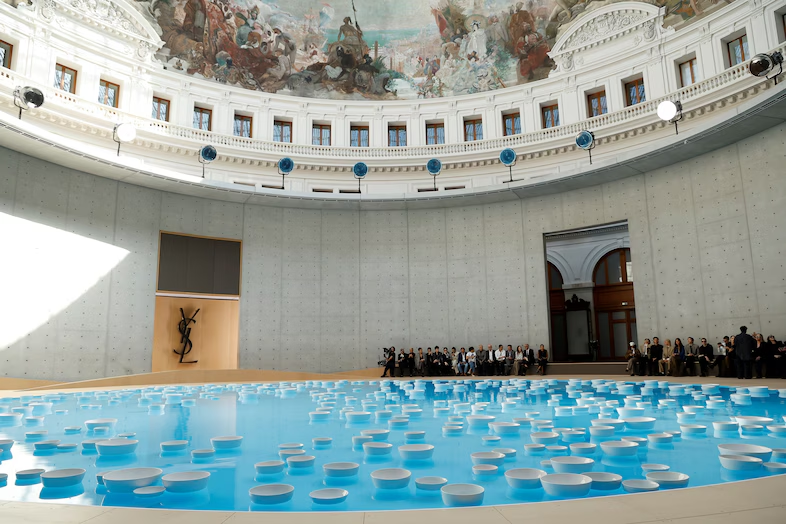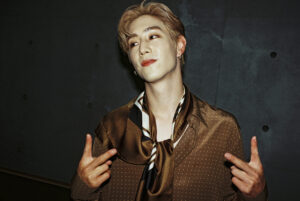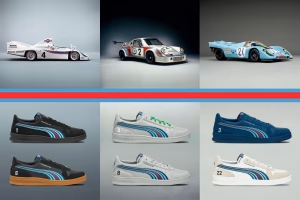
The Bourse de Commerce in Paris is no stranger to quiet revolutions. A monument steeped in centuries of economic transactions, it has been transformed by Tadao Ando into a contemporary art sanctuary. On Tuesday evening, Anthony Vaccarello staged what might be one of his most cerebral and poetic collections yet for Saint Laurent Mens Spring Summer 2026. Here, in a space echoing with the gentle clink of porcelain bowls drifting in Céleste Boursier-Mougenot’s clinamen installation, he offered a meditation on restraint, vulnerability, and redefined masculinity.
Since taking over the creative reins at Saint Laurent in 2016, Vaccarello has become synonymous with sharp tailoring, sexed-up silhouettes, and an almost cinematic evocation of Parisian nightlife. His men’s collections have often been populated by slick black leather, shimmering sequins, and louche silk shirts unbuttoned to the navel. But SS26 signaled a departure — an introspective pivot that feels both deeply personal and culturally attuned.
Gone was the rock god archetype that Yves Saint Laurent himself once reimagined for a generation of 1970s libertines. In its place, Vaccarello introduced an ethereal, nearly monastic aesthetic. The first look — a whisper-thin ivory silk blouse, tucked into pleated high-waist trousers — felt like a breath against the skin, as if the clothing itself wanted to vanish into light. Throughout the show, models glided in elongated tunics, kimono-inspired overcoats, and fluid pants that broke softly over the foot. The palette was a pale whisper: ivory, sable, ash, and subtle ink tones, occasionally punctuated by dusty rose or muted sage.
This new Saint Laurent man is not the defiant rebel storming the dance floors of Le Palace or Berlin’s Berghain; he is a reflective wanderer, navigating the fine line between vulnerability and power. Vaccarello’s cuts this season emphasized the waist — cinched by delicate silk sashes or sculptural belts, recalling the elegance of Dior’s New Look and its focus on a defined midsection. Yet, unlike Dior’s femme florals, these shapes felt architectural, almost as if each silhouette were a vessel designed to contain both strength and fragility.
One could sense the ghosts of past Saint Laurent revolutions moving silently through the space. Yves Saint Laurent was, after all, a master of introducing new ways of seeing the body — from the tuxedo jacket for women (Le Smoking) to safari suits and sheer blouses that scandalized polite society in the 1960s and ’70s. Vaccarello’s reconfiguration of menswear now challenges another entrenched notion: that masculinity must be armoured, loud, and brash.
Céleste Boursier-Mougenot’s clinamen installation — porcelain bowls drifting and gently colliding in a pool of water — acted as an apt metaphor for the collection. There was an elegance in their randomness, a poetic acceptance of imperfection and chance. Similarly, the garments seemed to float around the models, creating an aura of serenity rather than domination. The show soundtrack was minimal, the pace deliberate, encouraging the audience to truly look, not just consume.
After the final look disappeared into the luminous hush of the Bourse de Commerce, invited guests — including legendary filmmaker Francis Ford Coppola, model Amelia Gray, musician Sombr, and global icon Mark Tuan — moved backstage. There, they posed for Francesc Planes, who captured portraits that felt intimate, almost confessional. Gone were the performative grins or exaggerated poses of typical fashion week snaps. Instead, each subject appeared lost in thought, embodying the introspective energy of the collection itself.
It is worth noting that this quieter Saint Laurent comes at a time when fashion’s pace has become nearly untenable. The churn of seasons, the relentless social media cycle, and the push for instant virality have left many designers and consumers alike exhausted. Vaccarello’s decision to pull back, to focus on the subtleties of cut, drape, and movement, feels almost radical. It is an invitation to slow down, to reconnect with the tactile and the poetic — qualities often drowned out in the clamor of contemporary culture.
Historically, Saint Laurent has always occupied a space of tension: between the masculine and the feminine, tradition and rebellion, rigor and sensuality. This latest collection extends that tension into a new territory. The decision to lighten the materials, to soften the palette, and to remove the overt references to nightlife hedonism suggests a designer who is attuned to broader cultural shifts. It reflects a collective yearning for softness, for intimacy, for something beyond the aggressive spectacle that has defined much of 21st-century menswear.
Critics might argue that by stripping back the flamboyance, Vaccarello risks diluting the Saint Laurent DNA. Yet, one could counter that what he is doing is much closer to Yves’ original spirit — a fearless exploration of identity and the body. Rather than reiterating the codes of the past, he is distilling them, allowing each element to breathe and resonate anew.
The front-row attendance of Francis Ford Coppola is especially poignant. Coppola, who has famously spoken about the importance of silence and negative space in cinema, mirrors Vaccarello’s current approach to fashion. Just as a film can be shaped as much by what is left unsaid as by dialogue, so too can a garment be defined by what it does not shout. This kind of cross-disciplinary resonance highlights fashion’s capacity to engage in larger artistic and cultural conversations.
The evening closed not with the thunder of applause but with a contemplative murmur, as guests exited into the soft Parisian night. The city itself, a perpetual muse for Saint Laurent, seemed to echo the sentiment: an invitation to wander, to reflect, to imagine new shapes and ways of being.
As the porcelain bowls continued their silent choreography long after the models had gone, one felt that Vaccarello had not merely designed a collection but orchestrated an atmosphere, a mood, a fleeting yet unforgettable emotion. In doing so, he reaffirmed that fashion is not merely about clothes — it is about how we choose to inhabit our bodies and our worlds.
Saint Laurent Mens SS26 thus emerges not as a mere seasonal offering but as a manifesto of quiet power. It suggests that the most radical act today might not be to dazzle or provoke, but to listen, to feel, and to gently suggest. In a world clamoring for attention, Saint Laurent’s whisper may yet prove the loudest voice of all.
No comments yet.








